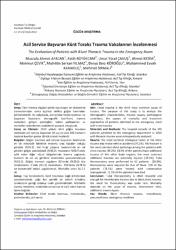Acil servise başvuran künt toraks travma vakalarının incelenmesi

Göster/
Erişim
info:eu-repo/semantics/openAccessTarih
2012-01Yazar
Afacan, Mustafa AhmetBüyükcam, Fatih
Çavuş, Umut Yücel
Kesim, Ahmet
Çevik, Mahmut
Yılmaz, Muhittin Serkan
Köroğlu, Derya Balcı
Karakılıç, Muhammed Evvah
Sırmalı, Mehmet
Üst veri
Tüm öğe kaydını gösterÖzet
Amaç: Tüm travma olguları içinde baş-boyun ve ekstremite
travmalarından sonra üçüncü sıklıkta göğüs travmaları
görülmektedir. Bu çalışmada, acil servise toraks travması ile
başvuran hastaların demografik özellikleri, travma
nedenleri, gelişen patolojiler, tedavi yaklaşımları ve
mortalite nedenlerinin analizlerini yapmak amaçlandı.
Gereç ve Yöntem: 2010 yılında künt göğüs travması nedeniyle acil servise başvuran 18 yaş ve üstü 305 hastanın
hastane kayıtları geriye dönük olarak incelendi.
Bulgular: Göğüs travması acil servise başvuran hastalarda
en sık etiyolojik faktörün motorlu araç kazaları olduğu
görüldü (%75.1). Kot kırığı çalışma hastalarında en sık
görülen göğüs patolojisiydi (%45.2). Hastaların %63.9'unda
eşlik eden diğer vücut bölgelerinde travma saptandı;
bunların da en sık görüleni ekstremite yaralanmalarıydı
(%33.1). Göğüs travmalı olguların 62’sinde (%20.3) tüp
torakostomi, 5’inde (%1.6) torakotomi, 238'ünde (%78.1)
ise konservatif tedavi uygulanmıştı. Mortalite oranı %11.1
idi.
Sonuç: Tüp torakostomi, künt travmaya bağlı intratorasik
yaralanmalarda çoğu kez gerekli ve yeterli olmakta;
torakotomi gereği oldukça nadir görülmektedir. Mortalite
travma nedenine, müdahale zamanına ve eşlik eden travma
tipine bağlıdır. Aim: Chest trauma is the third most common cause of
trauma. The purpose of this study is to analyze the
demographic characteristics, trauma causes, pathological
conditions, the causes of mortality and treatment
approaches of patients admitted to the emergency room with chest trauma.
Materials and Methods: The hospital records of the 305
patients admitted to the emergency department in 2010
with thoracic trauma were retrospectively analyzed.
Results: The most common etiological factor of the chest
trauma was motor vehicle accidents (75.1%). Rib fracture is
the most common chest pathology among the patients with
chest trauma (45.2%). 63.9% of the patients have additional
trauma of the other body regions, the most common
additional traumas are extremity injuries ( 33.1%). Tube
thoracostomy were performed to 62 patients (20.3%),
thoracotomy were required for five of them. 238 of the
patients (78.1%) were treated with conservative
management. 11.1% of the patients have died.
Conclusion: Tube thoracostomy is often required and
enough for intrathoracic injuries due to blunt chest trauma;
the need for thoracotomy was quite rare. Mortality
depends on the cause of trauma, intervention time,
additional trauma types.
Kaynak
Afyon Kocatepe Üniversitesi, Kocatepe Tıp DergisiCilt
13Sayı
1Bağlantı
http://hdl.handle.net/11630/1986Koleksiyonlar
- Makaleler [452]


















